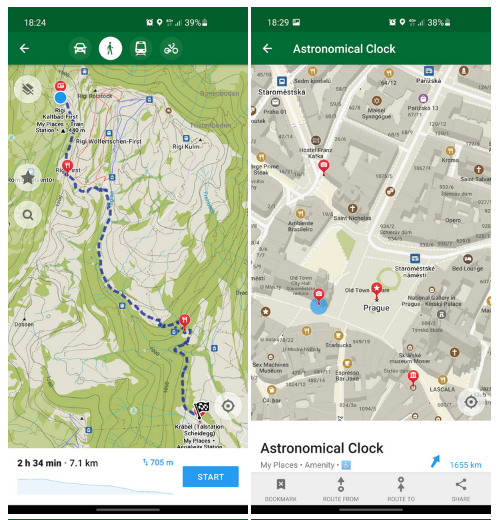08.06.2021-14.06.2021

Первый релиз Organic Maps [1] | © Organic Maps | map data © OpenStreetMap contributors
Картографические акции
- Иоахим Айзенберг сообщает
>
о первом картографическом мероприятии, которое организовало немецкое федеральное агентство по картографии и геодезии (BKG).
- Пользователь portalaventura информирует
>
об увеличивающейся активности платных мапперов в Бразилии.
Картографирование
- Пользователь AnuAnakTimur делится опытом по подключению древнего GPS приёмника к чуть менее древнему Android.
- Антон Хорев продолжает рассказывать о практике внесения и уточнения POI из мобильных приложений.
- Пользователь Hungerburg пишет
>
о сомнительности добавления
source=к объектам, нарисованным по аэрофотоснимкам. - Реддит-пользователь sporesofdoubt делится своими успехами в микромаппинге муниципальных парков города Финикс (Аризона).
- В 44 выпуске MilpaDigital (сайт со статьями о свободном ПО) рассказывается
>
об использовании uMap.
- Предложение по стандартизации тегирования административных границ в Португалии было принято
>
13 голосами за.
- Пользователь andygol подробно замапил [ua] лабиринт в киевском ботаническом саду.
- Идёт голосование:
- теги
amenity=*_libraryи подтегиlibrary:*=yes(по 23 июня). - уточняющие теги
utility=(по 28 июня).
- теги
Сообщество
- Пользователь dónal объясняет, как заливать в Mapillary видео с автомобильного регистратора.
- В блоге KartaView (бывший OpenStreetCam) появился пост с советами для новичков.
Фонд OpenStreetMap
- OSMF ищет разработчика для дальнейшего развития редактора iD.
- OSMF публикует новый вариант черновика Attribution Guidelines.
- На конференции State of the Map 2021 Совет OSMF проведёт виртуальную встречу, где его представителям можно будет задать любые интересующие вопросы.
События
- Команда Wikimedia Deutschland Technical Wishes планирует
>
поработать над улучшением поддержки геоинформационных технологий. С конца прошлого года идёт подготовительная фаза (#544). В конце этой фазы была проведено онлайн-совещание с презентацией
>
её результатов.
Гуманитарный OSM
- В феврале HOT проводил вебинар «Колониализм в открытых данных и картографии». Недавно о нём был выпущен короткий отчёт.
Открытые данные
- Записи с конференции FOSSGIS, проходившей с 6 по 9 июня, можно найти здесь
.
- Катя Хаферкорн и Астрид Эмде рассказали
>
о том, как проходила конференция FOSSGIS.
Программы
- [1] Organic Maps выпущен в основных магазинах мобильных приложений. Более подробно об этом можно почитать в заметке на Хабре. Ситуацию с Organic Maps мы уже освещали ранее (#547, #564, #567).
- Mapillary объявляет о множестве изменений: убрана возможность входа со сторонними учётными записями, отключены многие функции веб-редактора, а также веб-загрузчик. Кроме того, пользователям Android нужно будет скачать новое приложение. Зато теперь можно фильтровать фотографии по возрасту и получать доступ к 3D-информации. Кроме того, появился новый API.
А вы знаете …
- … о «Бесценной карте»
>
, на которой показаны места, где можно оставить какие-то ненужные вещи, чтобы кто-нибудь забрал их бесплатно или очень дёшево (например,
amenity=give_box,shop=charity,shop=second_handилиamenity=toy_library)?
Другие “гео” события
- Герд Гюльденпфенниг и Стефан Зиберт представили
>
Routado Assist — пешеходный навигатор для слабовидящих.
- Maps Mania замечает, что NASA не может позволить себе купить лицензию на Google Maps API, несмотря на бюджет в 22 миллиарда долларов.
- Производитель видеокарт NVIDIA покупает компанию DeepMap, которая специализируется на сверхподробных картах для беспилотных автомобилей.
Предстоящие события
Примечание: Если вы хотите видеть своё мероприятие здесь, добавьте его в календарь. Данные оттуда автоматически появятся в еженедельнике. Не забудьте указать город и страну.
Над этим выпуском работали: 4004, Nordpfeil, TheSwavu, derFred, richter_fn.